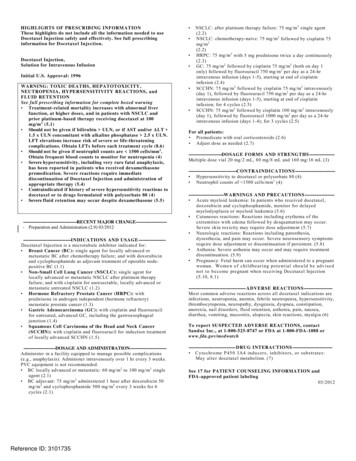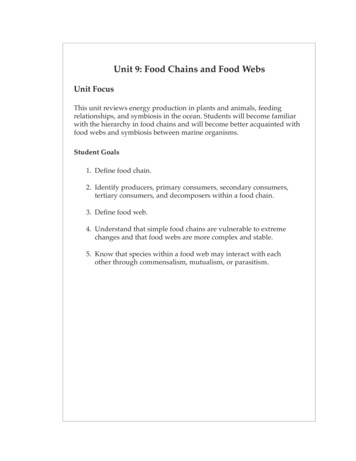
Transcription
HIGHLIGHTS OF PRESCRIBING INFORMATIONThese highlights do not include all the information needed to useDocetaxel Injection safely and effectively. See full prescribinginformation for Docetaxel Injection. Docetaxel Injection,Solution for Intravenous Infusion Initial U.S. Approval: 1996WARNING: TOXIC DEATHS, HEPATOTOXICITY,NEUTROPENIA, HYPERSENSITIVITY REACTIONS, andFLUID RETENTIONSee full prescribing information for complete boxed warning Treatment-related mortality increases with abnormal liverfunction, at higher doses, and in patients with NSCLC andprior platinum-based therapy receiving docetaxel at 100mg/m 2 (5.1) Should not be given if bilirubin ULN, or if AST and/or ALT 1.5 x ULN concomitant with alkaline phosphatase 2.5 x ULN.LFT elevations increase risk of severe or life-threateningcomplications. Obtain LFTs before each treatment cycle (8.6) Should not be given if neutrophil counts are 1500 cells/mm 3 .Obtain frequent blood counts to monitor for neutropenia (4) Severe hypersensitivity, including very rare fatal anaphylaxis,has been reported in patients who received dexamethasonepremedication. Severe reactions require immediatediscontinuation of Docetaxel Injection and administration ofappropriate therapy (5.4) Contraindicated if history of severe hypersensitivity reactions todocetaxel or to drugs formulated with polysorbate 80 (4) Severe fluid retention may occur despite dexamethasone --RECENT MAJOR CHANGE-------------------------- - Preparation and Administration (2.9) NDICATIONS AND USAGE-----------------------Docetaxel Injection is a microtubule inhibitor indicated for: Breast Cancer (BC): single agent for locally advanced ormetastatic BC after chemotherapy failure; and with doxorubicinand cyclophosphamide as adjuvant treatment of operable nodepositive BC (1.1) Non-Small Cell Lung Cancer (NSCLC): single agent forlocally advanced or metastatic NSCLC after platinum therapyfailure; and with cisplatin for unresectable, locally advanced ormetastatic untreated NSCLC (1.2) Hormone Refractory Prostate Cancer (HRPC): withprednisone in androgen independent (hormone refractory)metastatic prostate cancer (1.3) Gastric Adenocarcinoma (GC): with cisplatin and fluorouracilfor untreated, advanced GC, including the gastroesophagealjunction (1.4) Squamous Cell Carcinoma of the Head and Neck Cancer(SCCHN): with cisplatin and fluorouracil for induction treatmentof locally advanced SCCHN (1.5)----------------------------DOSAGE AND ADMINISTRATION------------------------------- Administer in a facility equipped to manage possible complications(e.g., anaphylaxis). Administer intravenously over 1 hr every 3 weeks.PVC equipment is not recommended. BC locally advanced or metastatic: 60 mg/m 2 to 100 mg/m 2 singleagent (2.1) BC adjuvant: 75 mg/m 2 administered 1 hour after doxorubicin 50mg/m 2 and cyclophosphamide 500 mg/m2 every 3 weeks for 6cycles (2.1)Reference ID: 3101735 NSCLC: after platinum therapy failure: 75 mg/m 2 single agent(2.2)NSCLC: chemotherapy-naive: 75 mg/m2 followed by cisplatin 75mg/m 2(2.2)HRPC: 75 mg/m 2 with 5 mg prednisone twice a day continuously(2.3)GC: 75 mg/m 2 followed by cisplatin 75 mg/m2 (both on day 1only) followed by fluorouracil 750 mg/m 2 per day as a 24-hrintravenous infusion (days 1-5), starting at end of cisplatininfusion (2.4)SCCHN: 75 mg/m 2 followed by cisplatin 75 mg/m 2 intravenously(day 1), followed by fluorouracil 750 mg/m2 per day as a 24-hrintravenous infusion (days 1-5), starting at end of cisplatininfusion; for 4 cycles (2.5)SCCHN: 75 mg/m 2 followed by cisplatin 100 mg/m2 intravenously(day 1), followed by fluorouracil 1000 mg/m 2 per day as a 24-hrintravenous infusion (days 1-4); for 3 cycles (2.5)For all patients: Premedicate with oral corticosteroids (2.6) Adjust dose as needed (2.7)-----------------------------DOSAGE FORMS AND STRENGTHS--------------------- Multiple dose vial 20 mg/2 mL, 80 mg/8 mL and 160 mg/16 mL AINDICATIONS---------------------------------- Hypersensitivity to docetaxel or polysorbate 80 (4) Neutrophil counts of 1500 cells/mm 3 (4)-------------------------------WARNINGS AND PRECAUTIONS------------------------- Acute myeloid leukemia: In patients who received docetaxel,doxorubicin and cyclophosphamide, monitor for delayedmyelodysplasia or myeloid leukemia (5.6) Cutaneous reactions: Reactions including erythema of theextremities with edema followed by desquamation may occur.Severe skin toxicity may require dose adjustment (5.7) Neurologic reactions: Reactions including paresthesia,dysesthesia, and pain may occur. Severe neurosensory symptomsrequire dose adjustment or discontinuation if persistent. (5.8) Asthenia: Severe asthenia may occur and may require treatmentdiscontinuation. (5.9) Pregnancy: Fetal harm can occur when administered to a pregnantwoman. Wo me n o f c h i l d b ea ri n g p o t e n t i a l s h o u l d b e a d v i s e dn o t to b eco me pregnant when receiving Docetaxel Injection(5.10, ----ADVERSE REACTIONS------------------------ Most common adverse reactions across all docetaxel indications areinfections, neutropenia, anemia, febrile neutropenia, hypersensitivity,thrombocytopenia, neuropathy, dysgeusia, dyspnea, constipation,anorexia, nail disorders, fluid retention, asthenia, pain, nausea,diarrhea, vomiting, mucositis, alopecia, skin reactions, myalgia (6)To report SUSPECTED ADVERSE REACTIONS, contactSandoz Inc., at 1-800-525-8747 or FDA at 1-800-FDA-1088 ------------- DRUG INTERACTIONS---------------------------------- Cytochrome P450 3A4 inducers, inhibitors, or substrates:May alter docetaxel metabolism. (7)See 17 for PATIENT COUNSELING INFORMATION andFDA-approved patient labeling03/2012
FULL PRESCRIBING INFORMATION: CONTENTS*WARNING1 INDICATIONS AND USAGE1.1 Breast Cancer1.2 Non-Small Cell Lung Cancer1.3 Prostate Cancer1.4 Gastric Adenocarcinoma1.5 Head and Neck Cancer2 DOSAGE AND ADMINISTRATION2.1 Breast Cancer2.2 Non-Small Cell Lung Cancer2.3 Prostate Cancer2.4 Gastric Adenocarcinoma2.5 Head and Neck Cancer2.6 Premedication Regimen2.7 Dosage Adjustments During Treatment2.8 Administration Precautions2.9 Preparation and Administration2.10 Stability3 DOSAGE FORMS AND STRENGTHS4 CONTRAINDICATIONS5 WARNINGS AND PRECAUTIONS5.1 Toxic Deaths5.2 Hepatic Impairment5.3 Hematologic Effects5.4 Hypersensitivity Reactions5.5 Fluid Retention5.6 Acute Myeloid Leukemia5.7 Cutaneous reaction5.8 Neurologic Reactions5.9 Asthenia5.10 Use in PregnancyReference ID: 31017356 ADVERSE REACTIONS6.1 Clinical Trials Experience6.2 Post Marketing Experiences7 DRUG INTERACTIONS8 USE IN SPECIFIC POPULATIONS8.1 Pregnancy8.3 Nursing Mothers8.4 Pediatric Use8.5 Geriatric Use8.6 Hepatic Impairment10 OVERDOSAGE11 DESCRIPTION12 CLINICAL PHARMACOLOGY12.1 Mechanism of Action12.3 Human Pharmacokinetics13 NONCLINICAL TOXICOLOGY13.1 Carcinogenesis, Mutagenesis, Impairment of Fertility14 CLINICAL STUDIES14.1 Locally Advanced or Metastatic Breast Cancer14.2 Adjuvant Treatment of Breast Cancer14.3 Non-Small Cell Lung Cancer (NSCLC)14.4 Hormone Refractory Prostate Cancer14.5 Gastric Adenocarcinoma14.6 Head and Neck Cancer15 REFERENCES16 HOW SUPPLIED/STORAGE AND HANDLING16.1 How Supplied16.2 Storage16.3 Handling and Disposal17 PATIENT COUNSELING INFORMATION*Sections or subsections omitted from the full prescribing information are notlisted
FULL PRESCRIBING INFORMATIONWARNING: TOXIC DEATHS, HEPATOTOXICITY, NEUTROPENIA,HYPERSENSITIVITY REACTIONS, and FLUID RETENTIONThe incidence of treatment-related mortality associated with docetaxel therapy isincreased in patients with abnormal liver function, in patients receiving higherdoses, and in patients with non-small cell lung carcinoma and a history of priortreatment with platinum-based chemotherapy who receive docetaxel as a singleagent at a dose of 100 mg/m2 [see Warning and Precautions (5.1)].Docetaxel Injection should not be given to patients with bilirubin upper limit ofnormal (ULN), or to patients with AST and/or ALT 1.5 x ULN concomitant withalkaline phosphatase 2.5 x ULN. Patients with elevations of bilirubin orabnormalities of transaminase concurrent with alkaline phosphatase are atincreased risk for the development of grade 4 neutropenia, febrile neutropenia,infections, severe thrombocytopenia, severe stomatitis, severe skin toxicity, andtoxic death. Patients with isolated elevations of transaminase 1.5 x ULN also had ahigher rate of febrile neutropenia grade 4 but did not have an increased incidence oftoxic death. Bilirubin, AST or ALT, and alkaline phosphatase values should beobtained prior to each cycle of Docetaxel Injection therapy [see Warning andPrecautions (5.2)]. Docetaxel Injection therapy should not be given to patients withneutrophil counts of 1500 cells/mm3. In order to monitor the occurrence ofneutropenia, which may be severe and result in infection, frequent blood cell countsshould be performed on all patients receiving Docetaxel Injection [see Warning andPrecautions (5.3)].Severe hypersensitivity reactions characterized by generalized rash/erythema,hypotension and/or bronchospasm, or very rarely fatal anaphylaxis, have beenreported in patients who received a 3-day dexamethasone premedication.Hypersensitivity reactions require immediate discontinuation of the DocetaxelInjection infusion and administration of appropriate therapy [see Warning andPrecautions (5.4)]. Docetaxel Injection must not be given to patients who have ahistory of severe hypersensitivity reactions to docetaxel or to other drugsformulated with polysorbate 80 [see Contraindications (4)].Severe fluid retention occurred in 6.5% (6/92) of patients despite use of a 3-daydexamethasone premedication regimen. It was characterized by one or more ofthe following events: poorly tolerated peripheral edema, generalized edema, pleuraleffusion requiring urgent drainage, dyspnea at rest, cardiac tamponade, orpronounced abdominal distention (due to ascites) [see Warning and Precautions(5.5)].1.INDICATIONS AND USAGE1.1 Breast CancerDocetaxel Injection is indicated for the treatment of patients with locally advanced ormetastatic breast cancer after failure of prior chemotherapy.Reference ID: 3101735
Docetaxel Injection in combination with doxorubicin and cyclophosphamide is indicatedfor the adjuvant treatment of patients with operable node-positive breast cancer.1.2 Non-Small Cell Lung CancerDocetaxel Injection as a single agent is indicated for the treatment of patients with locallyadvanced or metastatic non-small cell lung cancer after failure of prior platinum-basedchemotherapy.Docetaxel Injection in combination with cisplatin is indicated for the treatment of patientswith unresectable, locally advanced or metastatic non-small cell lung cancer who havenot previously received chemotherapy for this condition.1.3 Prostate CancerDocetaxel Injection in combination with prednisone is indicated for the treatment ofpatients with androgen independent (hormone refractory) metastatic prostate cancer.1.4 Gastric AdenocarcinomaDocetaxel Injection in combination with cisplatin and fluorouracil is indicated for thetreatment of patients with advanced gastric adenocarcinoma, includingadenocarcinoma of the gastroesophageal junction, who have not received priorchemotherapy for advanced disease.1.5 Head and Neck CancerDocetaxel Injection in combination with cisplatin and fluorouracil is indicated for theinduction treatment of patients with locally advanced squamous cell carcinoma of the headand neck (SCCHN).2.DOSAGE AND ADMINISTRATIONFor all indications, toxicities may warrant dosage adjustments [see Dosage andAdministration (2.7)].Administer in a facility equipped to manage possible complications (e.g. anaphylaxis).2.1 Breast Cancer For locally advanced or metastatic breast cancer after failure of prior chemotherapy,the recommended dose of Docetaxel Injection is 60 mg/m2 to 100 mg/m2administered intravenously over 1 hour every 3 weeks. For the adjuvant treatment of operable node-positive breast cancer, the recommendedDocetaxel Injection dose is 75 mg/m2 administered 1 hour after doxorubicin 50mg/m2 and cyclophosphamide 500 mg/m2 every 3 weeks for 6 courses. ProphylacticG-CSF may be used to mitigate the risk of hematological toxicities [see Dosageand Administration (2.7)].2.2 Non-Small Cell Lung Cancer Reference ID: 3101735For treatment after failure of prior platinum-based chemotherapy, docetaxel was
evaluated as monotherapy, and the recommended dose is 75 mg/m2 administeredintravenously over 1 hour every 3 weeks. A dose of 100 mg/m2 in patients previouslytreated with chemotherapy was associated with increased hematologic toxicity,infection, and treatment-related mortality in randomized, controlled trials [see BoxedWarning, Dosage and Administration (2.7), Warnings and Precautions (5), ClinicalStudies (14)]. For chemotherapy-naïve patients, docetaxel was evaluated in combination withcisplatin. The recommended dose of Docetaxel Injection is 75 mg/m2administered intravenously over 1 hour immediately followed by cisplatin 75mg/m 2 over 30-60 minutes every 3 weeks [see Dosage and Administration (2.7)].2.3 Prostate cancer For hormone-refractory metastatic prostate cancer, the recommended dose ofDocetaxel Injection is 75 mg/m 2 every 3 weeks as a 1 hour intravenousinfusion. Prednisone 5 mg orally twice daily is administered continuously [seeDosage and Administration (2.7)].2.4 Gastric adenocarcinoma For gastric adenocarcinoma, the recommended dose of Docetaxel Injection is 75mg/m2 as a 1 hour intravenous infusion, followed by cisplatin 75 mg/m 2 , as a 1to 3 hour intravenous infusion (both on day 1 only), followed by fluorouracil 750mg/m2 per day given as a 24-hour continuous intravenous infusion for 5 days, startingat the end of the cisplatin infusion. Treatment is repeated every three weeks.Patients must receive premedication with antiemetics and appropriatehydration for cisplatin administration [see Dosage and Administration (2.7)].2.5 Head and Neck CancerPatients must receive premedication with antiemetics, and appropriate hydration(prior to and after cisplatin administration). Prophylaxis for neutropenic infectionsshould be administered. All patients treated on the docetaxel containing arms of theTAX323 and TAX324 studies received prophylactic antibiotics. Induction chemotherapy followed by radiotherapy (TAX323)For the induction treatment of locally advanced inoperable SCCHN, therecommended dose of Docetaxel Injection is 75 mg/m2 as a 1 hour intravenousinfusion followed by cisplatin 75 mg/m2 intravenously over 1 hour, on day one,followed by fluorouracil as a continuous intravenous infusion at 750 mg/m2 per dayfor five days. This regimen is administered every 3 weeks for 4 cycles. Followingchemotherapy, patients should receive radiotherapy. [see Dosage and Administration(2.7)]. Induction chemotherapy followed by chemoradiotherapy (TAX324)For the induction treatment of patients with locally advanced (unresectable, lowsurgical cure, or organ preservation) SCCHN, the recommended dose of DocetaxelReference ID: 3101735
Injection is 75 mg/m 2 as a 1 hour intravenous infusion on day 1, followed bycisplatin 100 mg/m2 administered as a 30-minute to 3 hour infusion, followed byfluorouracil 1000 mg/m2/day as a continuous infusion from day 1 to day 4. Thisregimen is administered every 3 weeks for 3 cycles. Following chemotherapy,patients should receive chemoradiotherapy [see Dosage and Administration (2.7)].2.6 Premedication RegimenAll patients should be premedicated with oral corticosteroids (see below for prostatecancer) such as dexamethasone 16 mg per day (e.g., 8 mg twice daily) for 3 days starting 1day prior to Docetaxel Injection administration in order to reduce the incidence and severityof fluid retention as well as the severity of hypersensitivity reactions [see BoxedWarning, Warnings and Precautions (5.4)].For hormone-refractory metastatic prostate cancer, given the concurrent use of prednisone,the recommended premedication regimen is oral dexamethasone 8 mg, at 12 hours, 3 hoursand 1 hour before the Docetaxel Injection infusion [see Warnings and Precautions (5.4)].2.7 Dosage Adjustments During TreatmentBreast CancerPatients who are dosed initially at 100 mg/m2 and who experience either febrileneutropenia, neutrophils 500 cells/mm3 for more than 1 week, or severe or cumulativecutaneous reactions during Docetaxel Injection therapy should have the dosage adjustedfrom 100 mg/m2 to 75 mg/m2. If the patient continues to experience these reactions, thedosage should either be decreased from 75 mg/m2 to 55 mg/m2 or the treatment should bediscontinued. Conversely, patients who are dosed initially at 60 mg/m2 and who do notexperience febrile neutropenia, neutrophils 500 cells/mm3 for more than 1 week,severe or cumulative cutaneous reactions, or severe peripheral neuropathy duringDocetaxel Injection therapy may tolerate higher doses. Patients who develop grade 3peripheral neuropathy should have Docetaxel Injection treatment discontinued entirely.Combination Therapy with Docetaxel Injection in the Adjuvant Treatment of Breast CancerDocetaxel Injection in combination with doxorubicin and cyclophosphamide should beadministered when the neutrophil count is 1,500 cells/mm3. Patients who experiencefebrile neutropenia should receive G-CSF in all subsequent cycles. Patients who continueto experience this reaction should remain on G-CSF and have their Docetaxel Injectiondose reduced to 60 mg/m2. Patients who experience grade 3 or 4 stomatitis should havetheir Docetaxel Injection dose decreased to 60 mg/m2. Patients who experience severe orcumulative cutaneous reactions or moderate neurosensory signs and/or symptoms duringDocetaxel Injection therapy should have their dosage of Docetaxel Injection reduced from75 to 60 mg/m2. If the patient continues to experience these reactions at 60 mg/m2,treatment should be discontinued.Non-Small Cell Lung CancerMonotherapy with Docetaxel Injection for NSCLC treatment after failure of priorplatinum-based chemotherapyPatients who are dosed initially at 75 mg/m2 and who experience either febrileReference ID: 3101735
neutropenia, neutrophils 500 cells/mm3 for more than one week, severe or cumulativecutaneous reactions, or other grade 3/4 non-hematological toxicities during DocetaxelInjection treatment should have treatment withheld until resolution of the toxicity andthen resumed at 55 mg/m2. Patients who develop grade 3 peripheral neuropathyshould have Docetaxel Injection treatment discontinued entirely.Combination therapy with Docetaxel Injection for chemotherapy-naïve NSCLCFor patients who are dosed initially at Docetaxel Injection 75 mg/m2 in combination withcisplatin, and whose nadir of platelet count during the previous course of therapy is 25,000 cells/mm3, in patients who experience febrile neutropenia, and in patients withserious non-hematologic toxicities, the Docetaxel Injection dosage in subsequent cyclesshould be reduced to 65 mg/m2. In patients who require a further dose reduction, a dose of50 mg/m2 is recommended. For cisplatin dosage adjustments, see manufacturers'prescribing information.Prostate CancerCombination therapy with Docetaxel Injection for hormone-refractory metastatic prostatecancerDocetaxel Injection should be administered when the neutrophil count is 1,500cells/mm3. Patients who experience either febrile neutropenia, neutrophils 500 cells/mm3for more than one week, severe or cumulative cutaneous reactions or moderateneurosensory signs and/or symptoms during Docetaxel Injection therapy should havethe dosage of Docetaxel Injection reduced from 75 to 60 mg/m2. If the patientcontinues to experience these reactions at 60 mg/m2, the treatment should bediscontinued.Gastric or Head and Neck CancerDocetaxel Injection in combination with cisplatin and fluorouracil in gastric cancer orhead and neck cancerPatients treated with Docetaxel Injection in combination with cisplatin and fluorouracilmust receive antiemetics and appropriate hydration according to current institutionalguidelines. In both studies, G-CSF was recommended during the second and/or subsequentcycles in case of febrile neutropenia, or documented infection with neutropenia, orneutropenia lasting more than 7 days. If an episode of febrile neutropenia, prolongedneutropenia or neutropenic infection occurs despite G-CSF use, the DocetaxelInjection dose should be reduced from 75 mg/m2 to 60 mg/m2 . If subsequent episodesof complicated neutropenia occur the Docetaxel Injection dose should be reduced from 60mg/m2 to 45 mg/m2. In case of grade 4 thrombocytopenia the Docetaxel Injection doseshould be reduced from 75 mg/m2 to 60 mg/m2. Patients should not be retreated withsubsequent cycles of Docetaxel Injection until neutrophils recover to a level 1,500cells/mm3 and platelets recover to a level 100,000 cells/mm3. Discontinue treatment ifthese toxicities persist. [see Warnings and Precautions (5.3)].Recommended dose modifications for toxicities in patients treated with DocetaxelInjection in combination with cisplatin and fluorouracil are shown in Table 1.Reference ID: 3101735
Table 1 - Recommended Dose Modifications for Toxicities in Patients Treated withDocetaxel Injection in Combination with Cisplatin and FluorouracilDosage adjustmentToxicityFirst episode: reduce fluorouracil dose by 20%.Diarrhea grade 3Second episode: then reduce Docetaxel Injection dose by20%.First episode: reduce Docetaxel Injection and fluorouracilDiarrhea grade 4doses by 20%.Second episode: discontinue treatment.Stomatitis/mucositis First episode: reduce fluorouracil dose by 20%.grade 3Second episode: stop fluorouracil only, at all subsequentcycles.Third episode: reduce Docetaxel Injection dose by 20%.Stomatitis/mucositis First episode: stop fluorouracil only, at all subsequentgrade 4cycles.Second episode: reduce Docetaxel Injection dose by 20%.Liver dysfunction:In case of AST/ALT 2.5 to 5 x ULN and AP 2.5 x ULN, or AST/ALT 1.5 to 5 x ULNand AP 2.5 to 5 x ULN, Docetaxel Injection should be reduced by 20%.In case of AST/ALT 5 x ULN and/or AP 5 x ULN Docetaxel Injection should bestopped.The dose modifications for cisplatin and fluorouracil in the gastric cancer study areprovided below:Cisplatin dose modifications and delaysPeripheral neuropathy: A neurological examination should be performed before entryinto the study, and then at least every 2 cycles and at the end of treatment. In the case ofneurological signs or symptoms, more frequent examinations should be performed andthe following dose modifications can be made according to NCIC-CTC grade: Grade 2: Reduce cisplatin dose by 20%. Grade 3: Discontinue treatment.Ototoxicity: In the case of grade 3 toxicity, discontinue treatment.Nephrotoxicity: In the event of a rise in serum creatinine grade 2 ( 1.5 x normal value)despite adequate rehydration, CrCl should be determined before each subsequent cycle andthe following dose reductions should be considered (see Table 2).For other cisplatin dosage adjustments, also refer to the manufacturers' prescribinginformation.Reference ID: 3101735
Table 2 – Dose Reductions for Evaluation of Creatinine ClearanceCreatinine clearance resultbefore next cycleCrCl 60 mL/minCisplatin dose next cycleCrCl between 40 and 59mL/minDose of cisplatin was reduced by 50% at subsequentcycle. If CrCl was 60 mL/min at end of cycle, fullcisplatin dose was reinstituted at the next cycle.Full dose of cisplatin was given. CrCl was to be repeatedbefore each treatment cycle.If no recovery was observed, then cisplatin was omittedfrom the next treatment cycle.CrCl 40 mL/minDose of cisplatin was omitted in that treatment cycle only.If CrCl was still 40 mL/min at the end of cycle, cisplatinwas discontinued.If CrCl was 40 and 60 mL/min at end of cycle, a 50%cisplatin dose was given at the next cycle.If CrCl was 60 mL/min at end of cycle, full cisplatindose was given at next cycleCrCl Creatinine clearanceFluorouracil dose modifications and treatment delaysFor diarrhea and stomatitis, see Table 1.In the event of grade 2 or greater plantar-palmar toxicity, fluorouracil should be stoppeduntil recovery. The fluorouracil dosage should be reduced by 20%.For other greater than grade 3 toxicities, except alopecia and anemia, chemotherapy shouldbe delayed (for a maximum of 2 weeks from the planned date of infusion) until resolutionto grade 1 and then recommenced, if medically appropriate.For other fluorouracil dosage adjustments, also refer to the manufacturers' prescribinginformation.Combination Therapy with Strong CYP3A4 inhibitors:Avoid using concomitant strong CYP3A4 inhibitors (e.g., ketoconazole, itraconazole,clarithromycin, atazanavir, indinavir, nefazodone, nelfinavir, ritonavir, saquinavir,telithromycin and voriconazole). There are no clinical data with a dose adjustment inpatients receiving strong CYP3A4 inhibitors. Based on extrapolation from apharmacokinetic study with ketoconazole in 7 patients, consider a 50% DocetaxelInjection dose reduction if patients require co-administration of a strong CYP3A4inhibitor. [see Drug Interactions (7), Clinical Pharmacology (12.3)].Reference ID: 3101735
2.8 Administration PrecautionsDocetaxel Injection is a cytotoxic anticancer drug and, as with other potentially toxiccompounds, caution should be exercised when handling and preparing DocetaxelInjection solutions. The use of gloves is recommended. Please refer to [see HowSupplied/Storage and Handling (16.3)].If Docetaxel Injection or diluted solution for intravenous infusion should come intocontact with the skin, immediately and thoroughly wash with soap and water. If DocetaxelInjection or diluted solution for intravenous infusion should come into contact withmucosa, immediately and thoroughly wash with water.Contact of the Docetaxel Injection with plasticized PVC equipment or devices used toprepare solutions for infusion is not recommended. In order to minimize patient exposure tothe plasticizer DEHP (di-2-ethylhexyl phthalate), which may be leached from PVC infusionbags or sets, the final Docetaxel Injection dilution for infusion should be stored inbottles (glass, polypropylene) or plastic bags (polypropylene, polyolefin) andadministered through polyethylene-lined administration sets.Docetaxel Injection requires dilution prior to administration. Please follow the preparationinstructions provided below.2.9 Preparation and AdministrationDocetaxel Injection (10 mg/mL) requires NO prior dilution with a diluent and is ready toadd to the infusion solution.Dilution for Infusion1.Aseptically withdraw the required amount of Docetaxel Injection solution (10 mgdocetaxel/mL) with a calibrated syringe and inject (as a single injection) into a 250 mLinfusion bag or bottle of either 0.9% Sodium Chloride solution or 5% Dextrose solution toproduce a final concentration of 0.3 to 0.74 mg/mL.If a dose greater than 200 mg of Docetaxel Injection is required, use a larger volume of theinfusion vehicle so that a concentration of 0.74 mg/mL Docetaxel Injection is not exceeded.2.Thoroughly mix the infusion bag or bottle manually by gentle inversion and rotation in acontrolled manner and avoid foaming. Shaking or vigorous agitation should be avoidedduring preparation and transportation to the patient for administration.3.As with all parenteral products, Docetaxel Injection should be inspected visually forparticulate matter or discoloration prior to administration whenever the solution andcontainer permit. If the Docetaxel Injection vial or diluted solution is not clear or appears tohave precipitation, these should be discarded.The Docetaxel Injection diluted solution for infusion should be administered intravenouslyas a 1-hour infusion under ambient room temperature below 25ºC (77ºF) and lightingconditions.2.10 StabilityDocetaxel Injection infusion solution, if stored between 2 C and 25 C (36 F and 77 F) isReference ID: 3101735
stable for 4 hours in either 0.9% Sodium Chloride solution or 5% Dextrose solution. Usewithin 4 hours including storage and administration. Do not freeze infusion solution.3.DOSAGE FORMS AND STRENGTHSDocetaxel Injection 10 mg/mL is supplied as 20 mg/2 mL, 80 mg/8 mL and 160 mg/16mL.Each mL of Docetaxel Injection contains 10 mg docetaxel; 80 mg polysorbate 80;648 mg polyethylene glycol 300; 275.9 mg alcohol 96% (v/v), and 4 mg citric acid.4.CONTRAINDICATIONS Docetaxel Injection is contraindicated in patients who have a history of severehypersensitivity reactions to docetaxel or to other drugs formulated with polysorbate80. Severe reactions, including anaphylaxis, have occurred [see Warnings andPrecautions (5.4)]. Docetaxel Injection should not be used in patients with neutrophil counts of 1500cells/mm3.5.WARNINGS AND PRECAUTIONS5.1 Toxic DeathsBreast CancerDocetaxel administered at 100 mg/m2 was associated with deaths considered possibly orprobably related to treatment in 2.0% (19/965) of metastatic breast cancer patients, bothpreviously treated and untreated, with normal baseline liver function and in 11.5% (7/61)of patients with various tumor types who had abnormal baseline liver function (AST and/orALT 1.5 times ULN together with AP 2.5 times ULN). Among patients dosed at 60mg/m2, mortality related to treatment occurred in 0.6% (3/481) of patients with normalliver function, and in 3 of 7 patients with abnormal liver function. Approximately half ofthese deaths occurred during the first cycle. Sepsis accounted for the majority of the deaths.Non-Small Cell Lung CancerDocetaxel administered at a dose of 100 mg/m2 in patients with locally advanced ormetastatic non-small cell lung cancer who had a history of prior platinum-base
dexamethasone premedication regimen. It was characterized by one or more of the following events: poorly tolerated peripheral edema, generalized edema, pleural effusion requiring urgent drainage, dyspnea at rest, cardiac tamponade, or pronounced abdominal distention (due to ascites) [see Warning and Precautions (5.5)]. 1. INDICATIONS AND USAGE 1.1










